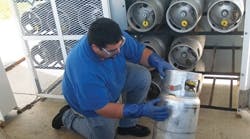The ability of propane-fueled forklifts to maintain consistent power throughout operation and offer rapid ground speed when needed makes them a popular choice inside and outside plants and warehouses. With more than 600,000 of them working in U.S. operations, and many experienced forklift operators nearing retirement, it is important that facility ownership and management adequately prepare the next generation for proper maintenance of these vehicles.
Training offered by propane providers can help operators determine the best and safest refueling approach to meet their needs. This can include cylinder exchange or on-site dispensing, which may be used in facilities that use both propane-fueled forklifts and work trucks fueled by propane autogas. Propane providers will work with local municipalities and states to ensure the installed infrastructure meets state and local regulations.
Cylinder exchange programs usually include installation of a storage cage in a central location that is easily accessible to forklift operators. Propane providers replace empty cylinders with full counterparts through a just-in-time inventory schedule that meets a facility’s needs, ensuring that a forklift fleet will never have too much or not enough fuel on hand. Facility owners and managers can work with propane providers as they add more equipment to their fleets or if refueling needs change.
After refueling installation, propane providers train owners and operators on proper safety procedures. They also instruct a facility’s on-site trainers on proper personal protective equipment (PPE) to use and share safety materials.
The Cylinder Exchange
Refueling through cylinder exchange is a straightforward process for forklift operators who use appropriate refueling techniques and follow safety procedures. Before starting, operators should always put on appropriate PPE including gloves and eyewear, and make sure the forklift ignition is off. Once operators are properly protected, the Propane Education & Research Council (PERC) advises them to follow these steps for cylinder exchange refueling:
1. Remove. Close the cylinder valve and remove the quick-disconnect coupling from the cylinder. Remove the empty cylinder from the cradle and store it in a designated safe area.
2. Inspect. Select a full cylinder and check it for damage and leaks. Be sure to inspect the fuel lines and forklift connector couplings for damage or signs of aging. Ensure the cylinder valve is closed prior to connecting.
3. Replace. Carefully install the filled cylinder in the cradle on the forklift so the cylinder locator pin enters the locating hole in the cylinder collar. Reconnect the fuel line to the cylinder liquid service value and open it slowly.
4. Mount. Securely mount the cylinder in its brackets within the outline of the vehicle. If any locator pins are broken or missing, take the forklift out of service, as propane may vent or indicate that the cylinder is empty when it is not. If any leaks are found, notify the supervisor.
These steps should not be considered a substitute for safety training courses taught by a local propane provider.
Stuart Flatow is vice president of safety and training for the Propane Education & Research Council. For more information on propane refueling procedures and safety training, contact your local propane provider, or visit PERC’s website, www.autogasusa.org.




